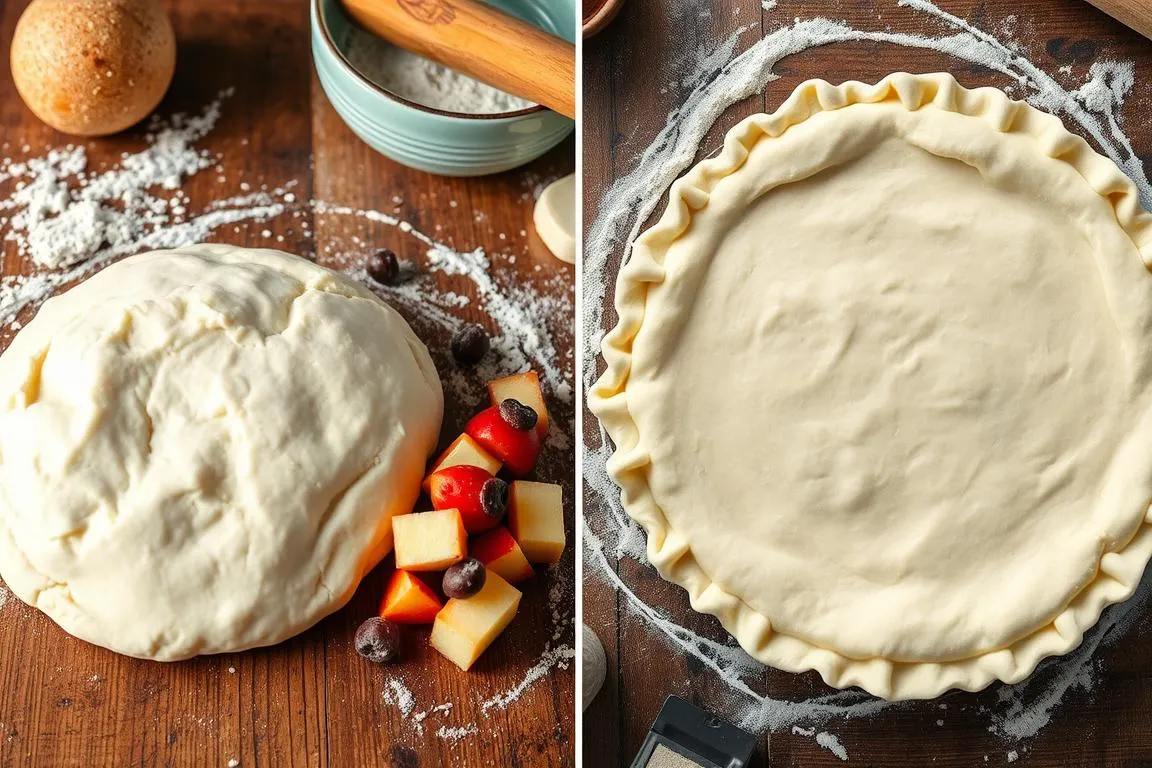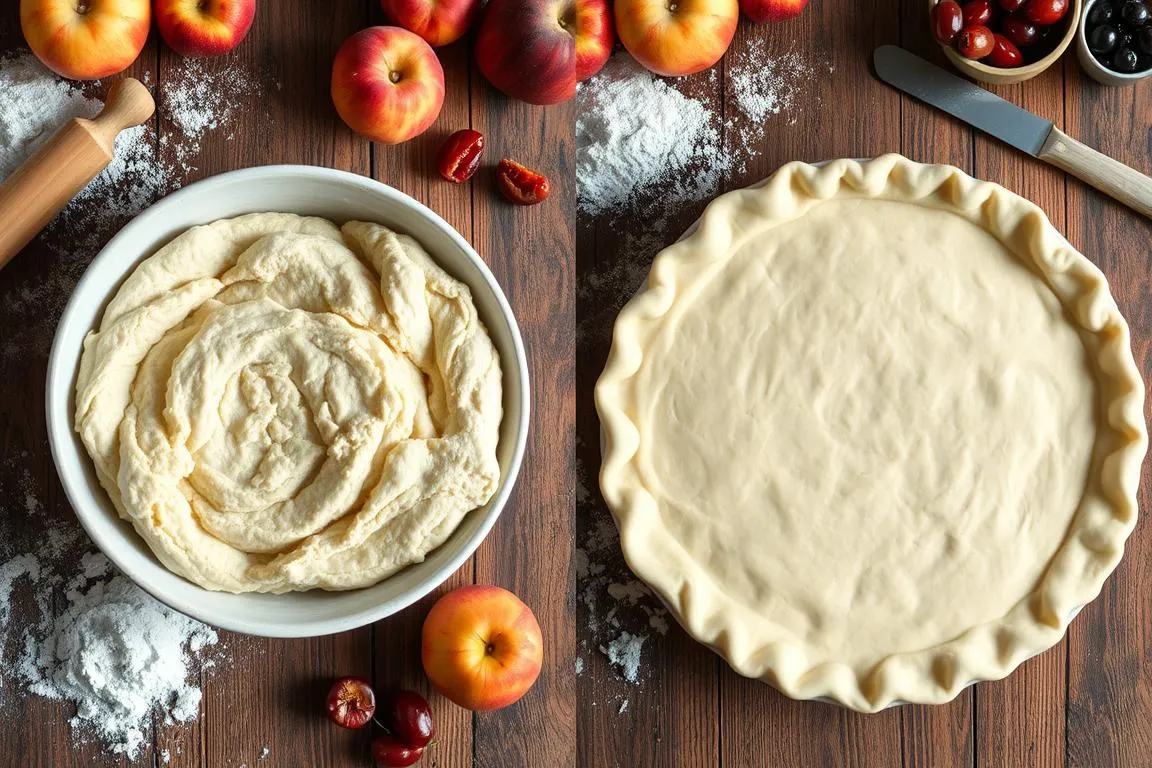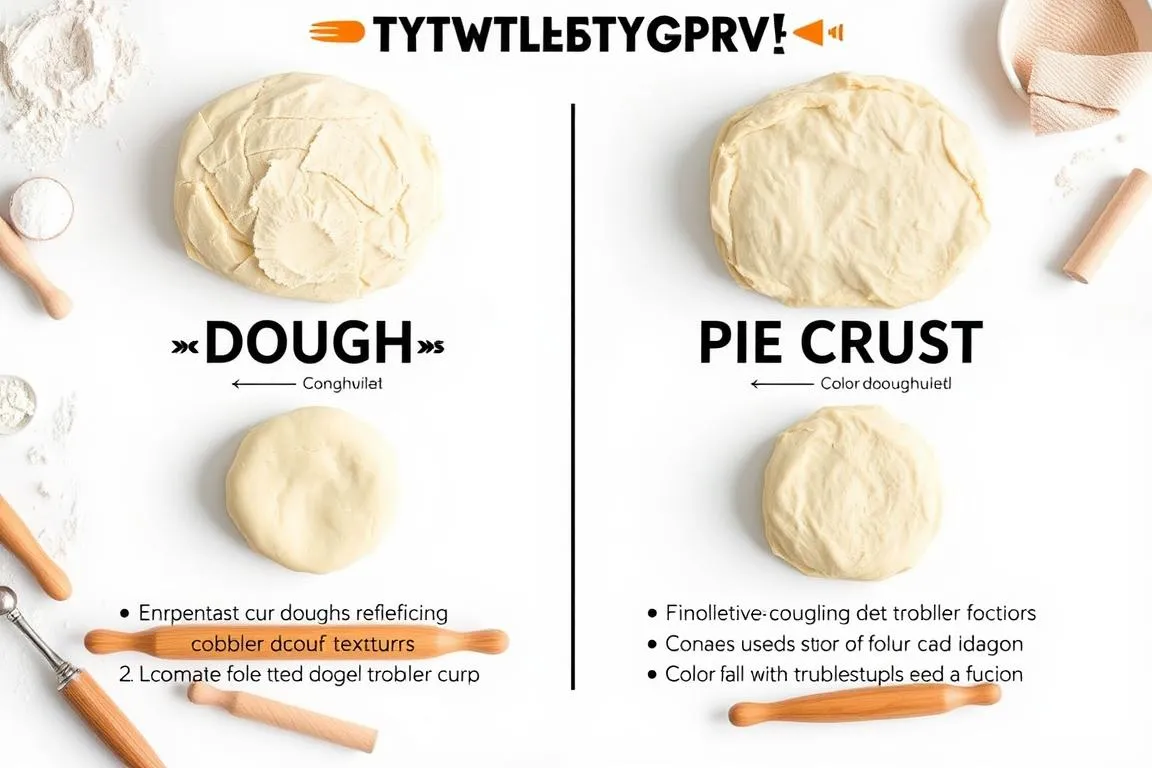Is cobbler dough the same as pie crust .Baking fans often ask if cobbler dough and pie crust are the same. They might look similar, but they’re not. Our guide will show you how they differ.
For those who love baking, knowing the difference is key. Making great cobbler dough or pie crust takes skill and knowledge. This guide is for anyone who wants to improve their baking skills.
Key Takeaways
- Cobbler dough and pie crust have distinct ingredient compositions
- Texture and preparation methods differ significantly
- Understanding pastry science improves baking results
- Regional baking traditions influence dough characteristics
- Proper technique is essential for perfect pastry consistency
Understanding the Basic Differences Between Cobbler Dough and Pie Crust
Baking fans often ask about the differences between cobbler dough and pie crust. These differences are not just about looks. They involve the dough’s makeup and the ingredients used, leading to unique tastes and textures.
Chemical Composition and Ingredients
The key to a great pastry is its ingredients. Pie crust needs a mix of flour, cold butter, and a little water for flakiness. Cobbler dough, on the other hand, uses ingredients for a softer, cake-like texture.
- Pie Crust Ingredients:
- All-purpose flour
- Cold unsalted butter
- Ice water
- Pinch of salt
- Cobbler Dough Ingredients:
- All-purpose flour
- Baking powder
- Milk or buttermilk
- Butter or shortening
Texture and Structure Variations
The dough’s makeup changes the final product’s texture. Pie crust is meant to be crisp and break easily. Cobbler dough, on the other hand, is softer and soaks up fruit juices.
“The magic of baking lies in understanding how ingredients interact and transform,” says professional pastry chef Emily Roberts.
Traditional Recipe Components
Traditional recipes show the unique ways to make pie crust and cobbler dough. Pie crust needs a gentle touch and cold ingredients to avoid toughening. Cobbler dough, by contrast, is made with a more relaxed mixing method for a softer texture.
| Characteristic | Pie Crust | Cobbler Dough |
|---|---|---|
| Mixing Method | Minimal handling | More relaxed mixing |
| Fat Content | Higher butter ratio | Moderate fat content |
| Moisture Level | Minimal liquid | More liquid incorporated |
The Science Behind Pie Crust Making
Pie crust science is more than just mixing ingredients. It’s about the complex mix of flour, fat, and liquid. This mix is key to making that flaky pastry every baker wants.
Understanding how molecules interact is essential. Gluten is a big player in the texture of pie crust. When flour and liquid mix, proteins start to form. This network shapes the pastry’s final look and feel.
“Baking is a science, and pie crust is its most delicate experiment.” – Professional Baker’s Wisdom
Critical Components of Pie Crust Formation
- Fat distribution impacts flakiness
- Temperature control ensures optimal texture
- Protein content influences structural integrity
Fat is vital for flaky layers. Cold butter or shortening creates steam pockets. These pockets make the dough layers separate, giving the crust its flaky texture.
| Ingredient | Scientific Function | Impact on Texture |
|---|---|---|
| Flour | Protein network formation | Structural foundation |
| Butter | Steam pocket creation | Flakiness development |
| Water | Hydration and gluten activation | Dough malleability |
The Maillard reaction turns pie crusts into golden wonders. It’s a chemical process that happens when amino acids and sugars meet heat. This creates amazing flavors and colors.
Professional bakers know that exact temperature and ingredient mix are key. By learning these science lessons, your baking will go from good to great.
Essential Components of Traditional Cobbler Dough
Making a perfect cobbler starts with knowing its basic ingredients and techniques. It’s all about precision, skill, and loving baking chemistry.
Key Ingredients for Perfect Cobbler Dough
Choosing the right ingredients is key for a great cobbler. The main parts are:
- All-purpose flour
- Cold unsalted butter
- Sugar
- Salt
- Ice water
Mixing Techniques and Tips
Mixing dough is a skill that makes a big difference. It’s all about being gentle and avoiding too much gluten.
- Keep ingredients cold
- Cut butter into small cubes
- Use a pastry cutter or fingertips
- Mix until just combined
- Avoid overworking the dough
“The secret to a perfect cobbler lies in the delicate balance of ingredients and technique.” – Professional Baker’s Handbook
Common Mistakes to Avoid
Experienced bakers know some mistakes can ruin a cobbler. Here are the big ones to avoid:
| Mistake | Consequence | Prevention |
|---|---|---|
| Warm butter | Tough, dense crust | Use cold butter, chill ingredients |
| Overmixing | Chewy, dense texture | Mix until ingredients just combine |
| Incorrect water temperature | Inconsistent dough texture | Use ice-cold water |
Mastering cobbler dough takes practice, patience, and attention to detail. By understanding these fundamental principles, you’ll be well on your way to creating stunning desserts that delight and impress.
Is Cobbler Dough the Same as Pie Crust?
Baking fans often ask about the differences between cobbler dough and pie crust. Both are key in making tasty desserts. Yet, they have special traits that make them different in baking.
The pastry comparison shows big differences in how they’re made and used. Cobbler dough is more relaxed and free-form. Pie crust, on the other hand, needs careful technique and gentle handling.
- Cobbler dough: Looser, more forgiving texture
- Pie crust: Requires precise layering and technique
- Baking differences impact final dessert structure
“Understanding the nuanced differences between cobbler dough and pie crust can elevate your baking from good to extraordinary.” – Professional Pastry Chef
The debate between cobbler dough and pie crust focuses on ingredients and how they’re prepared. Pie crusts need cold ingredients and gentle touch for flaky texture. Cobbler dough, though, is more flexible.
| Characteristic | Cobbler Dough | Pie Crust |
|---|---|---|
| Texture | Rustic, softer | Flaky, delicate |
| Ingredient Ratio | More forgiving | Precise measurements |
| Preparation | Less technical | Requires skilled technique |
Professional bakers know each pastry type has its own role in cooking. They respect each one’s unique qualities.
Techniques for Achieving the Perfect Flaky Pie Crust
Making a flaky pie crust is all about precision and skill. Professional bakers see it as an art that turns simple desserts into amazing treats. The key to a great pie crust is knowing how to mix ingredients and use the right techniques.
Temperature Control Methods
Temperature is very important for a flaky pie crust. Your baking plan should keep ingredients cold. Here are some tips for controlling temperature:
- Chill butter and shortening for at least 30 minutes before mixing
- Use ice-cold water when combining ingredients
- Work quickly to prevent ingredient warming
- Refrigerate dough between mixing and rolling
Rolling and Shaping Strategies
Rolling the dough right is key for a flaky crust. Here’s what professional bakers do:
- Use a cold marble or granite surface for rolling
- Roll from the center outward in gentle motions
- Rotate dough periodically to ensure even thickness
- Avoid overworking the dough to maintain flakiness
Pre-baking Considerations
| Pie Type | Pre-baking Recommendation | Technique |
|---|---|---|
| Custard Pies | Always pre-bake | Blind baking with pie weights |
| Fruit Pies | Typically not pre-baked | Direct filling method |
| Cream Pies | Pre-bake completely | Full blind baking process |
“The difference between a good pie and a great pie is in the crust” – Professional Pastry Chef
Getting good at making flaky pie crust takes time and effort. By using these techniques and strategies, home bakers can make pies that are as good as those in restaurants. They will surely impress your family and friends.
How to Master Cobbler Dough Consistency
Making the perfect cobbler dough is all about precision and understanding baking basics. It’s an art that requires attention to detail and skill.
To get the right baking consistency, you need to know your dough’s ingredients. The right mix can make your cobbler’s texture amazing.
- Measure ingredients precisely
- Use cold butter for flakier texture
- Handle dough minimally to prevent toughness
- Check moisture levels carefully
“The secret to perfect cobbler dough is respecting the ingredients and understanding their interactions.” – Professional Pastry Chef
Temperature is key in making dough. Warm ingredients can ruin the texture. So, keep butter and liquids cold.
| Ingredient | Temperature Impact | Recommended Approach |
|---|---|---|
| Butter | Must remain cold | Chill before mixing |
| Liquid | Affects gluten development | Use ice-cold water |
| Flour | Influences protein structure | Sift before measuring |
Getting good at cobbler dough takes time and patience. Watch for visual and touch cues when checking consistency. Your dough should be just right, with flaky layers from the butter.
- Mix dry ingredients first
- Cut in cold butter quickly
- Add liquid sparingly
- Rest dough before rolling
Professional bakers know it’s not just about following a recipe. It’s about technique and practice. Try different methods and learn from each try to improve your skills.
Regional Variations in Cobbler and Pie Preparations
The world of regional baking is full of diverse traditions. These traditions show the rich cultural heritage of American desserts. Cobbler and pie recipes vary by region, influenced by local ingredients and family secrets.
Southern-Style Traditions
Southern baking is known for its excellence. Peach cobbler is a classic Southern dessert, loved for generations. It often includes:
- Fresh, locally sourced fruit
- Butter-rich crusts
- Traditional cast-iron skillet preparation
Modern Adaptations
Today’s bakers are putting their own spin on old recipes. Innovative twists make classic cobbler and pie recipes fresh again. They use new ingredients and techniques.
| Region | Unique Cobbler Variation | Key Ingredients |
|---|---|---|
| Pacific Northwest | Marionberry Cobbler | Local marionberries, lavender honey |
| New England | Cranberry Apple Cobbler | Tart cranberries, local apples, maple syrup |
| Southwest | Prickly Pear Cobbler | Prickly pear fruit, cinnamon, agave |
Cultural Influences
Baking traditions show the multicultural richness of American cuisine. Communities add their own twist to cobbler and pie recipes. This turns these desserts into stories of their origins and people.
“Every cobbler tells a story of its origin, its people, and their connection to the land.” – Local Pastry Chef
From California’s orchards to Appalachia’s kitchens, regional baking keeps evolving. It celebrates both tradition and innovation in every delicious bite.
Troubleshooting Common Dough Problems
Dough troubleshooting can turn a baking disaster into a tasty success. Professional bakers know how to fix pastry problems. Knowing common dough issues helps you improve your baking skills.
“Baking is about precision, but also about knowing how to recover when things don’t go perfectly.” – Professional Baker’s Wisdom
Let’s look at some common dough problems and how to fix them:
- Tough Dough: Often caused by overworking the mixture or using too much water
- Crumbly Texture: Indicates insufficient liquid or fat in the recipe
- Shrinking Crust: Results from inadequate resting time before baking
Finding the root cause is key to fixing pastry problems. Each issue has a specific solution to save your baking project.
| Dough Problem | Potential Cause | Solution |
|---|---|---|
| Tough Crust | Excessive gluten development | Minimize mixing, use cold ingredients |
| Crumbly Texture | Low fat content | Add more butter or shortening gradually |
| Uneven Baking | Inconsistent oven temperature | Use an oven thermometer, rotate halfway through |
Professional dough troubleshooting needs patience and practice. Even experienced bakers face challenges. The important thing is to understand why problems happen and how to fix them.
Conclusion
Understanding the world of baking means knowing the difference between cobbler dough and pie crust. These techniques are more than just recipes. They are traditions that turn simple ingredients into delicious treats. Each style adds something special to home baking, making it truly amazing.
Every time you make dough, you learn something new. Whether it’s a Southern peach cobbler or an apple pie, this guide helps you start strong. Professional bakers know that it’s all about precision, practice, and passion.
Becoming a skilled baker is a never-ending journey. Learning about dough, temperature, and ingredients opens up a world of possibilities. Don’t be afraid to try new things and trust your growing skills.
Remember, every great baker was once in your shoes. They were curious, eager to learn, and ready to practice. Your hard work and dedication will take your baking to the next level.
FAQ
What is the main difference between cobbler dough and pie crust?
Cobbler dough is softer and more like a biscuit. It’s made to be dropped over fruit. Pie crust, on the other hand, is flaky and encases fillings completely.
Can I use the same recipe for cobbler dough and pie crust?
No, you can’t. Pie crust needs a specific mix of fat and flour for flakiness. Cobbler dough is more moist, making it cake-like.
What are the key ingredients in traditional cobbler dough?
Cobbler dough has flour, baking powder, salt, butter or shortening, and milk or buttermilk. These ingredients make the dough soft and tender, unlike pie crust.
How do I prevent my pie crust from becoming tough?
To avoid a tough pie crust, handle the dough little. Use cold ingredients and don’t overwork it. Keep butter cold and work fast for flakiness.
What’s the best way to achieve a flaky pie crust?
For a flaky crust, use cold ingredients and keep butter in small pieces. Handle the dough as little as possible. Work quickly to keep the butter from melting.
Are there regional differences in cobbler and pie preparations?
Yes, there are big differences. Southern cobblers have a biscuit-like topping. Midwestern and New England pies have flaky crusts and prefer certain fruits.
How can I troubleshoot a crumbly cobbler dough?
For a crumbly dough, add a little liquid at a time until it sticks together. Make sure ingredients are the right temperature and don’t overmix.
What’s the most common mistake when making pie crust?
The biggest mistake is overworking the dough. This makes it tough instead of flaky. Mix just until it comes together.
Can I make pie crust or cobbler dough in advance?
Yes, you can make both ahead of time. Pie crust can be refrigerated for 2-3 days or frozen for a month. Cobbler dough is best made just before baking.
What’s the best fat to use in pie crust?
Butter is best for flavor, but a mix of butter and shortening is ideal for flakiness. Some prefer all-butter for taste, while others like a 50/50 mix for texture.



